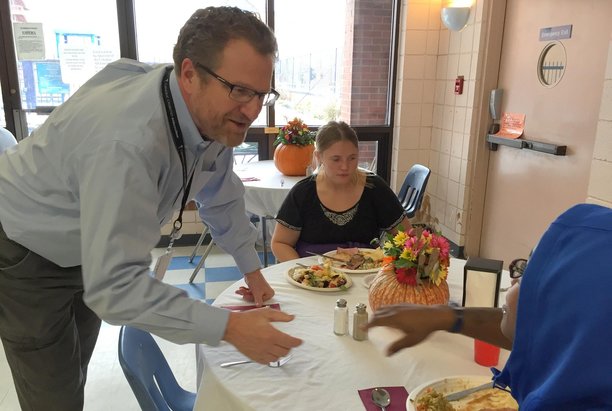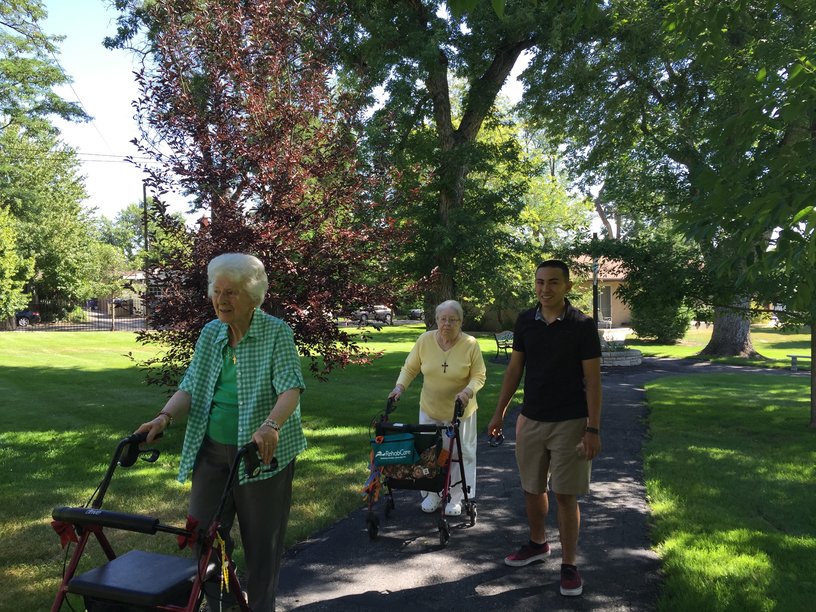‘Father Woody’: A Legacy of Mercy
Late Denver priest’s works of mercy still spread Christ’s love.

DENVER — “His life was a work of mercy.”
So said Regis University professor Victoria McCabe about the late Msgr. C.B. “Father Woody” Woodrich, Denver’s “patron saint of the hungry and homeless,” who co-founded the first shelter in the United States built specifically to house the homeless, helped expand the nation’s free and reduced school lunch program, and established and inspired other ministries to the needy that continue to this day.
Nov. 10 marks the 25th anniversary of his death.
Here’s a look at Father Woody and three ministries continuing his legacy of mercy.
Father Woody
In his 38 years as a priest, Charles Bert Woodrich, a transplant to Colorado from New York, headed archdiocesan communications, was editor of the Denver Catholic Register, pastored two urban churches and ministered as a hospital chaplain.
Prior to becoming a priest, he had spent five years in advertising and public relations in New York, where he was born and reared. When he died suddenly at age 68, an obituary in the newspaper he had led described him as “a blunt, tough-talking, fearless defender of the downtrodden.”
“He translated Scripture into deeds,” McCabe said about her former pastor. “His works of mercy were 100% embracing of every person he met, every minute of the day.”
Samaritan House
When Samaritan House opened on Nov. 22, 1986, it made history as the first building in the nation designed to be a homeless shelter. Its impetus, however, started three years earlier, when a bitter winter and oil bust in Denver forced hundreds into homelessness. Moved by their plight, Father Woody opened the doors of downtown Holy Ghost Church to provide refuge. Some people objected to one of the archdiocese’s most beautiful churches being used as a temporary shelter.
“Listen, Jesus Christ told us to take care of the least of our brothers and sisters. That means even if you have to hold your breath,” Father Woody declared to his congregation. “And we’re going to do that here at Holy Ghost Church. If you don’t like it, find another church.”
“My dear people,” he emphasized, “we cannot pray to the Lord and reject the ones he loves most.”
Soon afterward, the priest proposed the archdiocese convert an unused high school into a shelter. It drew local and national media attention when it opened to maximum capacity later that year. The recycled building was replaced with present-day Samaritan House, which is marking its 30th anniversary.

Samaritan House’s program to help the homeless become self-sufficient is remarkably successful: Last year 226 of its residents found employment, 91% of its single residents left with an income source, and 67% of its families left with housing, as did 64% of its single residents.
“It continues Father Woody’s legacy of mercy, in that it meets people right where they are and gives them what they need,” said Larry Smith, CEO of Catholic Charities Denver, which runs Samaritan House today. “Our goal is always to meet them with love, mercy and the compassion of Jesus Christ.”
Father Woody Programs
When McCabe arrived in Denver as a graduate student and was looking for a Latin Mass, she was referred to Holy Ghost Church.
“I went to 10am high Mass with the choir and Father Woody preaching,” she said. “Afterward, my husband said, ‘What do you think?’ I said, ‘I’m never going anywhere else.’”
“He was talking straight to me; he talked right to everyone’s heart — he just pierced it. He’d say, ‘You think you can sit in the pew for an hour and a half and call yourself Catholic? You gotta live it!’” she recalled. “I had to do a lot of soul-searching. I always went to Mass, but I didn’t do a lot [to help outside of church].”
Father Woody changed that. And when he changed McCabe, he also impacted the hundreds of students she would teach moving forward.
When Father Woody died, McCabe sent a letter to Mother Teresa of Calcutta, who had met Father Woody on two visits to Denver.
“She was his hero,” McCabe said, adding that, two weeks later, she got a personal response from the tiny nun who founded the Missionaries of Charity and was canonized this year.
“‘I’m so sorry to hear in Denver of the loss of beloved Father Woodrich; but he is with God now, and he would want you to quit crying and go do the work he showed you how to do,’” McCabe paraphrased.
McCabe immediately started the social-ministry project named “Father Woody Programs” at Regis University. Through it, more than 100 college students from Regis serve inner-city youth, the homeless and the elderly every year. Their work ranges from tutoring at inner-city Catholic schools and helping various entities to feed the homeless to assisting with the elderly at the Little Sisters of the Poor’s Mullen Home and co-sponsoring a renowned huge annual Christmas party replete with dinner and gifts for thousands of homeless and poor.

“It’s about living the Catholic faith,” McCabe said. “Living and doing it. I’m trying to translate Father Woody’s mission of ‘You can’t just talk; you have to live it — you have to help the poor.’ As a professor, I have to help (students) help others.”
Haven of Hope
“We believe that, had he lived, this is what he would have done,” said Don Gallegos, a former parishioner of Father Woody and now board president of Father Woody’s Haven of Hope day shelter.
After Father Woody died, Gallegos’ wife, Cheri, put a note with the words “Father Woody’s Haven of Hope” under an Infant of Prague statue in their home and told her husband, “Someday, we’re going to do something to carry on his legacy.”
Seven years later, Don Gallegos went to see an apostolate run out of an 800-square-foot house by several lay Franciscans. They were serving meals to the homeless, giving them haircuts, washing their clothes and letting them use a shower. He knew it was the type of service Father Woody would have wanted for the homeless he had fed daily through his parish sandwich line.
“Cheri, this is it,” Gallegos recalled telling his wife.
Because of the increasing numbers of homeless served by the day shelter, which was offering services not met by other agencies, a larger facility was soon needed. In October 2007, a 5,700-square-foot building was erected next door to the original house. The $1.5-million facility was named Father Woody’s Haven of Hope.
“Father Woody wanted it done,” Gallegos said, crediting the late priest with the providential way the land became available and the building was paid for by the time it opened.
Daily, Haven of Hope serves 300-plus breakfasts and more than 500 lunches, provides 70-plus private showers and does more than 45 loads of laundry.
Here, the homeless may make phone calls, use the internet, get clothing, receive mail, keep documents safe, receive help getting an ID and birth certificate, get clothing and become connected to other resources.
“We’re serving up to 800 people a day,” Gallegos said. “This is not a soup kitchen. The homeless do not have to stand in line to get their food; we take the food to them. The whole idea is to give them back their dignity.”
The day shelter has again outgrown its facilities, and so is adding a new four-story 6,200-square-foot wing, which should be completed by December. Nearly $1.7 million has been raised toward the $2-million cost.
The new wing will expand services to include GED classes, employment readiness and money management, as well as dental, eye and mental-health clinics and legal services.
The haven remains true to Father Woody’s mission to serve the homeless with respect, dignity and a friendly face, Gallegos said, as it carries out the priest’s motto: “We are here to serve, not to judge.”
Model of Faith
While pastor of inner-city Annunciation Parish, Father Woody learned that some of the schoolchildren were going hungry. So he took 16-by-20-inch photos of them to the White House and sat outside President Lyndon B. Johnson’s office for three days before getting the opportunity to tell him, “There’s a hole in your food program.” The next year, after signing the Child Nutrition Act, which expanded the free and reduced lunch program to include parochial schools, the president sent Father Woody a pen.
While pastor of Holy Ghost, Father Woody started the annual Christmas dinner with gifts for the homeless that McCabe’s students help the archdiocese and other donors and volunteers continue today, and he began a related annual money giveaway — now crisp $20 bills to adults and McDonald’s gift certificates to kids — that also continues in his name through benefactors.
As McCabe lovingly helped organize a memorial Mass and reception at Holy Ghost Church for the 25th anniversary of Father Woody’s death, her invitations carried the adage: “His works continue. His love endures.”
“He was such a convincing model of faith in action,” McCabe said. “That’s what saints are. They show us how to do it.”
Roxanne King writes from Denver.
Portions of this story previously appeared in Denver Catholic.
- Keywords:
- priests
- roxanne king
- works of mercy

















